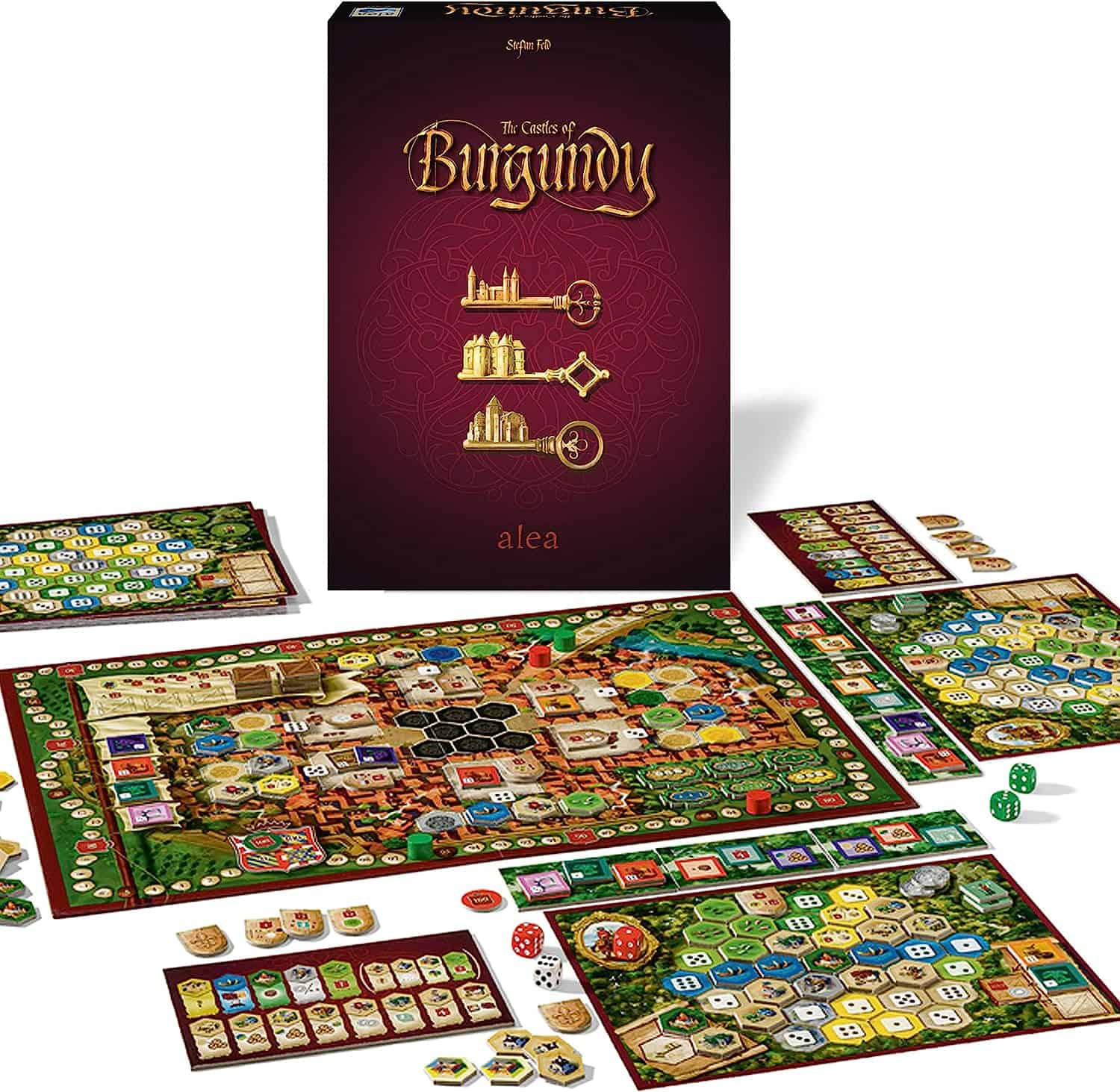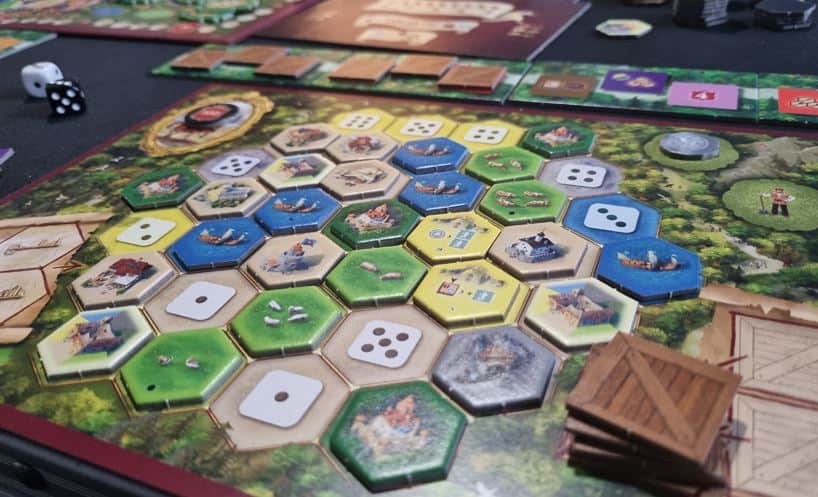Castles of Burgundy takes place in the historic region of Burgundy, France, during the High Middle Ages.
In this epic tale of strategy and expansion, players step into the shoes of aristocrats and landowners, striving to build their own principality within the scenic landscape. As they acquire and develop different types of tiles representing cities, buildings, and livestock, players embark on a journey of economic growth and territorial conquest.
Players must balance their ambitions with careful planning, as they strategically place tiles to construct thriving settlements, fortify their holdings, and compete for coveted regions.
As the game unfolds, players witness the rise and fall of dynasties, with each turn offering new opportunities and challenges. Castles of Burgundy captures the essence of medieval Europe, where cunning strategies, resource management, and a dash of luck determine who will emerge as the most influential landowner in this rich and storied region.
What’s included in Castles of Burgundy

- Game board depicting the region of Burgundy.
- Hexagonal tiles representing different types of buildings, goods, and landscapes.
- Player boards for each player, which depict their estate and storage areas.
- Player tokens to keep track of actions and bonuses.
- Dice with various symbols.
- A central supply of goods tiles.
- Victory point tokens.
How to play Castles of Burgundy

Setup
- Place the game board in the center of the table.
- Each player receives a player board, two worker tokens, and a set of colored tiles.
- Place the central supply of goods tiles nearby.
- Randomly determine the starting player.
Rules for Castles of Burgundy
The game is played over multiple rounds, with each round consisting of the following steps:
1. Roll Phase: The starting player rolls two dice. These dice represent the actions players can take during the round. Each die has six faces, each showing one of the following symbols: Ship, Castle, Mine, Silverling (Coin), Worker, or Nothing.
2. Action Phase: Starting with the first player and proceeding clockwise, players take turns using the dice results to perform actions. You can use the results of the dice in any order. The actions you can take include:
- Take a Tile: Spend a worker token to take a tile from the central supply and place it in your storage area.
- Place a Tile: Use a rolled die to place a tile from your storage onto your estate board. The tile must be placed in a location that matches the number on the die, and it must be adjacent to a tile already on your estate.
- Sell Goods: Use a rolled die to sell goods (tiles with the ship symbol) for silverlings (coins). The number on the die determines the type of good you can sell.
- Take Workers: Use a rolled die to take additional worker tokens.
- Use Knowledge Tiles: Spend worker tokens to use the special actions of your knowledge tiles.
3. End of Round: Once all players have taken their actions, the round ends. Check to see if any regions on your estate are completed (surrounded by tiles). If so, you score points based on the number on your completed region tile.
4. Cleanup: Return unused tiles to the central supply, pass the starting player marker to the left, and prepare for the next round.
Winning the Game: The game is played over several rounds, and the player with the most points at the end wins. Points are earned through various actions, including completing regions on your estate, selling goods, and using knowledge tiles effectively.
For the official rules, see the link below:
Strategies you should be considering
- Focus on Completing Regions:
- Completing regions on your estate is a primary source of points. Aim to close off areas of your board with tiles of the same color to earn points consistently.
- Pay Attention to Dice Results:
- The dice rolls dictate your available actions. Plan your moves based on the symbols rolled, but also be adaptable to changing circumstances.
- Consider using worker tokens to manipulate dice rolls to your advantage. This flexibility can be powerful.
- Balance Expansion and Scoring:
- Expanding your estate is crucial for long-term success, but don’t forget to score points as well. A balance between both is necessary.
- Use Workers Wisely:
- Worker tokens are a valuable resource. Spend them strategically to either manipulate dice or take additional actions.
- Using workers to unlock knowledge tiles can provide unique abilities and advantages.
- Adapt Your Strategy:
- Be ready to adjust your strategy based on the tiles available and your opponents’ actions. Flexibility can be a key to success.
- Pay Attention to Goods (Ships):
- Selling goods can provide a significant income of silverlings, which can be used for various purposes, including acquiring tiles and taking extra actions.
- Consider Special Tiles:
- Certain tiles have special abilities or bonus points. Look for opportunities to acquire and use these tiles effectively.
- Anticipate Scoring Rounds:
- Pay attention to the progress of your regions and try to complete them just before a scoring round to maximize points.
- Control Timing:
- Use your actions to control the timing of scoring rounds. If you can complete a region before your opponent is ready, you may gain a significant advantage.
- Plan for Endgame Scoring:
- Keep in mind the endgame bonuses for having specific types of tiles on your board. These bonuses can provide a final boost to your score.
- Compete for Key Tiles:
- In a multiplayer game, be aware of what your opponents are working on and consider competing for tiles they need to complete regions.
- Stay Consistent:
- Building a balanced estate with a variety of tiles can provide a consistent stream of points throughout the game.
Remember that “Castles of Burgundy” rewards long-term planning, adaptability, and efficient use of resources. It’s a game where small decisions can have a significant impact on your success, so think carefully and stay flexible as you build your estate in medieval France.